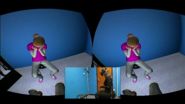(Press-News.org) LA JOLLA, CA - November 12, 2014 - Driving to work becomes routine--but could you drive the entire way in reverse gear? Humans, like many animals, are accustomed to seeing objects pass behind us as we go forward. Moving backwards feels unnatural.
In a new study, scientists from The Scripps Research Institute (TSRI) reveal that moving forward actually trains the brain to perceive the world normally. The findings also show that the relationship between neurons in the eye and the brain is more complicated than previously thought--in fact, the order in which we see things could help the brain calibrate how we perceive time, as well as the objects around us.
"We were trying to understand how that happens and the rules used during brain development," said the study's senior author Hollis Cline, who is the Hahn Professor of Neuroscience and member of the Dorris Neuroscience Center at TSRI.
This research, published this week in the journal Proceedings of the National Academy of Sciences could have implications for treating sensory processing disorders such as autism.
Reversing the Map
The new study began when Masaki Hiramoto, a staff scientist in Cline's lab, asked an important question: "How does the visual system of the brain get better "tuned" over time?"
Previous studies had shown that people use the visual system to create an internal map of the world. The key to creating this map is sensing the "optic flow" of objects as we walk or drive forward. "It's natural because we've learned it," said Cline.
To study how this system develops, Hiramoto and Cline used transparent tadpoles to watch as nerve fibers, called axons, developed between the retina and the brain. The scientists marked the positions of the axons using fluorescent proteins.
The tadpoles were split into groups and raised in small chambers. One group was shown a computer screen with bars of light that moved past the tadpoles from front to back--simulating a normal optic flow as if the animal were moving forward. A second group saw the bars in reverse--simulating an unnatural backwards motion. Using the TSRI Dorris Neuroscience Center microscopy facility, Hiramoto then captured high-resolution images of these neurons as they grew over time.
The researchers found that tadpoles' visual map developed normally when shown bars moving from front to back. But tadpoles shown the bars in reverse order extended axons to the wrong spots in their map. With those axons out of order, the brain would perceive visual images as reversed or squished.
Rewriting the Rules
This discovery challenges a rule in neuroscience that dates back to 1949. Until now, researchers knew it was important that neighboring neurons fired at roughly the same time, but didn't realize that the temporal sequence of firing was important.
"According to the old rule, if there was a stimulus that went backwards, the map would be fine," said Cline.
The new study adds the element of order. The researchers showed that objects moving from front to back in the visual field activated retinal cells in a specific sequence.
Cline and Hiramoto believe that this sequence helps the brain perceive the passage of time. For example, if you drive for a few minutes and pass a street sign, your brain will map its position behind you. If you keep driving and you pass another street sign, your brain will map out not only the street signs' positions relative to each other, but their distance in time as well.
This link between time and space in the visual system might also apply to hearing and the sense of touch. The original question of how the visual system gets "tuned" over time might be applicable across the entire brain.
The researchers believe this study could have implications for patients with sensory and temporal processing disorders, including autism and a mysterious disorder called Alice in Wonderland syndrome, where a person perceives objects as disproportionately big or small. Cline said the new study offers possibilities for retraining the brain to map the world correctly, for instance after stroke.
INFORMATION:
More information on the study, "Optic flow instructs retinotopic map formation through a spatial to temporal to spatial transformation of visual information," is available at: http://www.pnas.org/content/early/2014/11/05/1416953111.abstract
Support for the work came from the National Institutes of Health (EY011261 and DP1OD000458), the Nancy Lurie Marks Family Foundation and an endowment from the Hahn Family Foundation.
(MEMPHIS, Tenn. - November 12, 2014) An international collaboration has identified frequent mutations in two genes that often occur together in Ewing sarcoma (EWS) and that define a subtype of the cancer associated with reduced survival. The research, conducted by the St. Jude Children's Research Hospital-Washington University Pediatric Cancer Genome Project and the Institut Curie-Inserm through the International Cancer Genome Consortium, appears in the current issue of the scientific journal Cancer Discovery.
Mutations in the genes STAG2 and TP53 have previously been ...
Giant otters may have a vocal repertoire with 22 distinct vocalization types produced by adults and 11 neonate vocalization types, according to a study published November 12, 2014 in the open-access journal PLOS ONE by Christina Mumm and Mirjam Knörnschild from University of Ulm, Germany.
Giant otters, found in South America, are very social and frequently vocalizing animals. They live in groups that may vary, but generally include a reproductive pair and their offspring, born in different years. Individuals engage in shared group activities and hold different social ...
Using fewer than twenty genomes, researchers were unable to find rare protein-altering variants significantly associated with extreme longevity, according to a study published November 12, 2014 in the open-access journal PLOS ONE by Hinco Gierman from Stanford University and colleagues.
Supercentenarians are the world's oldest people, living beyond 110 years of age. Seventy-four are alive worldwide, with twenty-two living in the United States. The authors of this study performed whole-genome sequencing on 17 supercentenarians to explore the genetic basis underlying ...
An educational approach in kindergarten focused on the development of executive functions--the ability to avoid distractions, focus attention, hold relevant details in working memory, and regulate impulsive behavior--in children improved academic learning in and beyond kindergarten, helping to overcome deficits in school readiness associated with poverty, according to a study published November 12, 2014 in the open-access journal PLOS ONE by Clancy Blair and C. Cybele Raver from New York University.
Based on the results, the authors suggest that executive function ...
An educational approach focused on the development of children's executive functions - the ability to avoid distractions, focus attention, hold relevant information in working memory, and regulate impulsive behavior - improved academic learning in and beyond kindergarten, according to a new study by researchers at NYU's Steinhardt School of Culture, Education, and Human Development.
Because some effects were especially pronounced in high-poverty schools, the findings hold promise for closing the poverty-related achievement gap and suggest that an emphasis on executive ...
The normally bland face of Uranus has become increasingly stormy, with enormous cloud systems so bright that for the first time ever, amateur astronomers are able to see details in the planet's hazy blue-green atmosphere.
"The weather on Uranus is incredibly active," said Imke de Pater, professor and chair of astronomy at the University of California, Berkeley, and leader of the team that first noticed the activity when observing the planet with adaptive optics on the W. M. Keck II Telescope in Hawaii.
"This type of activity would have been expected in 2007, when Uranus's ...
In the fight against HIV, microbicides--chemical compounds that can be applied topically to the female genital tract to protect against sexually transmitted infections--have been touted as an effective alternative to condoms. However, while these compounds are successful at preventing transmission of the virus in a petri dish, clinical trials using microbicides have largely failed. A new study from the Gladstone Institutes and the University of Ulm now reveals that this discrepancy may be due to the primary mode of transportation of the virus during sexual transmission, ...
VIDEO:
The video illustrates the complete experiment. First the participant shown wearing the Oculus head-mounted display and the OptiTrack motion capture suit gives comfort to the crying virtual child. We see...
Click here for more information.
Self-compassion can be learned using avatars in an immersive virtual reality, finds new research led by UCL. This innovative approach reduced self-criticism and increased self-compassion and feelings of contentment in naturally self-critical ...
It is claimed one in five students have taken the 'smart' drug Modafinil to boost their ability to study and improve their chances of exam success. But new research into the effects of Modafinil has shown that healthy students could find their performance impaired by the drug.
The study carried out by Dr Ahmed Dahir Mohamed, in the School of Psychology at The University of Nottingham Malaysia Campus, and published today, Wednesday 12 November 2014, in the open access journal PLOS ONE, showed the drug had negative effects in healthy people.
Dr Mohamed said: "We looked ...
CORAL GABLES, Fla. (Nov. 12, 2014) -- Crowdsourcing utilizes the input of a crowd of online users to collaboratively solve problems. To advance this emerging technology, researchers at the University of Miami are developing a computing model that uses crowdsourcing to combine and optimize human efforts and machine computing elements.
The new model can be used to efficiently perform the complex tasks of face recognition--a method used in law enforcement. It's a new approach to using social networks as a formal part of the criminal investigation process, explained computer ...



